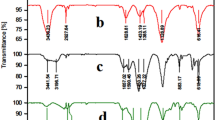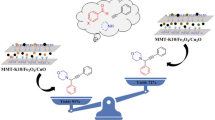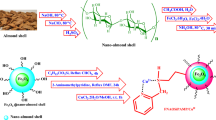Abstract
In the present work, we report the ultrasound-assisted one-pot three-component synthesis of novel antipyrine based α-aminophosphonates using TiO2/CNT nanocomposite as a heterogeneous catalyst. The synthesized TiO2/CNT nanocomposite was characterized using X-ray diffraction (XRD), Fourier transform infrared spectroscopy, Raman spectroscopy, thermogravimetry analysis, field emission scanning electron microscopy (FE-SEM), energy-dispersive X-ray spectroscopy (EDX) and transmission electron microscopy (TEM). The structural features of the TiO2/CNT nanocomposite were determined by XRD, FTIR and Raman analyses. XRD pattern confirmed that the synthesized nanocomposite is free of any rutile TiO2 impurities. EDX spectra aided in the quantitative estimation of the elements present in the nanocomposite. Further, the morphological attributes of the nanocomposite were studied using FE-SEM and TEM imaging. The use of TiO2/CNT nanocomposite as a heterogeneous catalyst in α-aminophosphonate synthesis has notable advantages such as short reaction time, solvent-free condition, easy work-up, remarkable yields of desired product, reusability up to five runs and use of ultrasonication as a green energy source.
Graphical abstract









Similar content being viewed by others
References
Merino P, Marqués-López E, Herrera RP (2008) Catalytic enantioselective hydrophosphonylation of aldehydes and imines. Adv Synth Catal 350:1195–1208
Nagrik DM, Wavhal KK (2020) An efficient synthesis of a-aminophosphonates through Kabachnik-fields reaction protocol by using cobalt chloride doped polyaniline as the nano catalyst. J Phys Conf Ser 1644:012038
Dake SA, Raut DS, Kharat KR, Mhaske RS, Deshmukh SU, Pawar RP (2011) Ionic liquid promoted synthesis, antibacterial and in vitro antiproliferative activity of novel α-aminophosphonate derivatives. Bioorg Med Chem Lett 21:2527–2532
Awad MK, Abdel-Aal MF, Atlam FM, Hekal HA (2019) Molecular docking, molecular modeling, vibrational and biological studies of some new heterocyclic α-aminophosphonates. Spectrochim Acta Part A 206:78–88
Shaikh S, Dhavan P, Ramana MMV, Jadhav BL (2021) Design, synthesis and evaluation of new chromone-derived aminophosphonates as potential acetylcholinesterase inhibitor. Mol Divers 25:811–825
Damiche R, Chafaa S (2017) Synthesis of new bioactive aminophosphonates and study of their antioxidant, anti-inflammatory and antibacterial activities as well the assessment of their toxicological activity. J Mol Struct 1130:1009–1017
Xu Y, Yan K, Song B, Xu G, Yang S, Xue W, Hu D, Lu P, Ouyang G, Jin L, Chen Z (2006) Synthesis and antiviral bioactivities of α-aminophosphonates containing alkoxyethyl moieties. Molecules 11:666–676
Shaikh S, Dhavan P, Pavale G, Ramana MMV, Jadhav BL (2020) Design, synthesis and evaluation of pyrazole bearing α-aminophosphonate derivatives as potential acetylcholinesterase inhibitors against Alzheimer’s disease. Bioorg Chem 96:103589
Awad MK, Abdel-Aal MF, Atlam FM, Hekal HA (2018) Design, synthesis, molecular modeling, and biological evaluation of novel α-aminophosphonates based quinazolinone moiety as potential anticancer agents: DFT, NBO and vibrational studies. J Mol Struct 1173:128–141
Allen MC, Fuhrer W, Tuck B, Wade R, Wood JM (1989) Renin inhibitors. Synthesis of transition-state analog inhibitors containing phosphorus acid derivatives at the scissile bond. J Med Chem 32:1652–1661
Kunde SP, Kanade KG, Karale BK, Akolkar HN, Arbuj SS, Randhavane PV, Shinde ST, Shaikh MH, Kulkarni AK (2020) Nanostructured N doped TiO2 efficient stable catalyst for Kabachnik-fields reaction under microwave irradiation. RSC Adv 10:26997–27005
Haji M (2016) Multicomponent reactions: a simple and efficient route to heterocyclic phosphonates. Beilstein J Org Chem 12:1269–1301
Kabachnik MI, Medved TY (1952) New synthesis of aminophosphonic acids. Dokl Akad Nauk SSSR 83:689–692
Fields EK (1952) The synthesis of esters of substituted amino phosphonic acids1a. J Am Chem Soc 74:1528–1531
Fan W, Queneau Y, Popowycz F (2018) The synthesis of HMF-based α-amino phosphonates via one-pot Kabachnik-fields reaction. RSC Adv 8:31496–31501
Keglevich G, Bálint E (2012) The Kabachnik-fields reaction: mechanism and synthetic use. Molecules 17:12821–12835
Reddy YT, Reddy PN, Kumar BS, Rajput P, Sreenivasulu N, Rajitha B (2007) TiCl4 -catalyzed efficient one-pot synthesis of α α-amino phosphonates. Phosphorus Sulfur Silicon Relat Elem 182:161–165
Hosseini-Sarvari M (2008) TiO2 as a new and reusable catalyst for one-pot three-component syntheses of α-aminophosphonates in solvent-free conditions. Tetrahedron 64:5459–5466
Zhan Z-P, Li J-P (2005) Bismuth(III) chloride–catalyzed three-component coupling: synthesis of α-amino phosphonates. Synth Commun 35:2501–2508
Sun P, Hu Z, Huang Z (2004) Gallium triiodide catalyzed organic reaction: a convenient synthesis of α-amino phosphonates. Synth Commun 34:4293–4299
Essid I, Touil S (2017) Efficient and green one-pot multi-component synthesis of α-aminophosphonates catalyzed by zinc triflate. Curr Org Synth 14:272–278
Sobhani S, Tashrifi Z (2009) Al(OTf)3 as an efficient catalyst for one-pot synthesis of primary diethyl 1-aminophosphonates under solvent-free conditions. Synth Commun 39:120–131
Ghosh R, Maiti S, Chakraborty A, Maiti DK (2004) In(OTf)3 catalysed simple one-pot synthesis of α-amino phosphonates. J Mol Catal A Chem 210:53–57
Azizi N, Rajabi F, Saidi MR (2004) A mild and highly efficient protocol for the one-pot synthesis of primary α-amino phosphonates under solvent-free conditions. Tetrahedron Lett 45:9233–9236
Bhagat S, Chakraborti AK (2007) An extremely efficient three-component reaction of aldehydes/ketones, amines, and phosphites (Kabachnik−fields reaction) for the synthesis of α-aminophosphonates catalyzed by magnesium perchlorate. J Org Chem 72:1263–1270
Wang S, Wang Z, Zha Z (2009) Metal nanoparticles or metal oxide nanoparticles, an efficient and promising family of novel heterogeneous catalysts in organic synthesis. J Chem Soc Dalt Trans 43:9363–9373
Khalilian S, Abdolmohammadi S, Nematolahi F (2017) An eco-friendly and highly efficient synthesis of pyrimidinones using a TiO2-CNTs nanocomposite catalyst. Lett Org Chem 14:361–367
Abdolmohammadi S, Mirza B, Vessally E (2019) Immobilized TiO2 nanoparticles on carbon nanotubes: an efficient heterogeneous catalyst for the synthesis of chromeno[b]pyridine derivatives under ultrasonic irradiation. RSC Adv 9:41868–41876
Safari J, Gandomi-Ravandi S (2014) Titanium dioxide supported on MWCNTs as an eco-friendly catalyst in the synthesis of 3,4-dihydropyrimidin-2-(1H)-ones accelerated under microwave irradiation. New J Chem 38:3514–3521
Serp P, Castillejos E (2010) Catalysis in carbon nanotubes. ChemCatChem 2:41–47
Woan K, Pyrgiotakis G, Sigmund W (2009) Photocatalytic carbon-nanotube-TiO2 composites. Adv Mater 21:2233–2239
Ashkarran AA, Fakhari M, Hamidinezhad H, Haddadi H, Nourani MR (2015) TiO2 nanoparticles immobilized on carbon nanotubes for enhanced visible-light photo-induced activity. J Mater Res Technol 4:126–132
Xu Y-J, Zhuang Y, Fu X (2010) New insight for enhanced photocatalytic activity of TiO2 by doping carbon nanotubes: a case study on degradation of benzene and methyl orange. J Phys Chem C 114:2669–2676
Zhu L, Meng Z-D, Cho K-Y, Oh W-C (2012) Synthesis of CdS/CNT-TiO2 with a high photocatalytic activity in photodegradation of methylene blue. New Carbon Mater 27:166–174
Lin K, Qian J, Zhao Z, Wu G, Wu H (2020) Synthesis of a carbon-loaded Bi2O2CO3/TiO2 photocatalyst with improved photocatalytic degradation of methyl orange dye. J Nanosci Nanotechnol 20:7653–7658
Shaari N, Tan SH, Mohamed AR (2012) Synthesis and characterization of CNT/Ce-TiO2 nanocomposite for phenol degradation. J Rare Earths 30:651–658
Olowoyo JO, Kumar M, Jain SL, Babalola JO, Vorontsov AV, Kumar U (2019) Insights into reinforced photocatalytic activity of the CNT–TiO2 nanocomposite for CO2 reduction and water splitting. J Phys Chem C 123:367–378
Shimizu Y, Ateia M, Wang M, Awfa D, Yoshimura C (2019) Disinfection mechanism of E. coli by CNT-TiO2 composites: photocatalytic inactivation vs. physical separation. Chemosphere 235:1041–1049
Abega AV, Ngomo HM, Nongwe I, Mukaya HE, Sone PMAK, Mbianda XY (2019) Easy and convenient synthesis of CNT/TiO2 nanohybrid by in-surface oxidation of Ti3+ ions and application in the photocatalytic degradation of organic contaminants in water. Synth Met 251:1–14
Safari J, Gandomi-Ravandi S (2014) Carbon nanotubes supported by titanium dioxide nanoparticles as recyclable and green catalyst for mild synthesis of dihydropyrimidinones/thiones. J Mol Struct 1065–1066:241–247
Abdolmohammadi S (2018) TiO2 NPs-coated carbone nanotubes as a green and efficient catalyst for the synthesis of [1]benzopyrano[b][1]benzopyranones and xanthenols in water. Comb Chem High Throughput Screen 21:594–601
Banerjee B (2019) Ultrasound and nano-catalysts: an ideal and sustainable combination to carry out diverse organic transformations. ChemistrySelect 4:2484–2500
Rasal SA, Tamore MS, Shimpi NG (2019) Ultrasound-mediated synthesis of novel α-aminophosphonates using graphene nanosheets-silver nanoparticles (GNS-AgNPs) as a recyclable heterogeneous catalyst. ChemistrySelect 4:2293–2300
Shaikh S, Rasal S, Ramana MMV (2021) Ultrasound assisted synthesis of pyrano[3,2-b]pyran and 7-tosyl-4,7-dihydropyrano[2,3-e]indole scaffolds using barium titanate nanoparticles. Reac Kinet Mech Cat 133:405–424
Bhatte KD, Sawant DN, Pinjari DV, Pandit AB, Bhanage BM (2012) One pot green synthesis of nano sized zinc oxide by sonochemical method. Mater Lett 77:93–95
Rodríguez LAA, Pianassola M, Travessa DN (2017) Production of TiO2 coated multiwall carbon nanotubes by the sol-gel technique. Mater Res 20:96–103
Xie Y, Qian H, Zhong Y, Guo H, Hu Y (2012) Facile low-temperature synthesis of carbon nanotube/TiO2 nanohybrids with enhanced visible-light-driven photocatalytic activity. Int J Photoenergy. https://doi.org/10.1155/2012/682138
Rodriguez LAA, Travessa DN (2018) Core/shell structure of TiO2-coated MWCNTs for thermal protection for high-temperature processing of metal matrix composites. Adv Mater Sci Eng 2018:1–11
Scheibe B, Borowiak-Palen E, Kalenczuk RJ (2010) Oxidation and reduction of multiwalled carbon nanotubes—preparation and characterization. Mater Charact 61:185–191
Abdi Y, Khalilian M, Arzi E (2011) Enhancement in photo-induced hydrophilicity of TiO2 /CNT nanostructures by applying voltage. J Phys D Appl Phys 44:255405
Stobinski L, Lesiak B, Kövér L, Tóth J, Biniak S, Trykowski G, Judek J (2010) Multiwall carbon nanotubes purification and oxidation by nitric acid studied by the FTIR and electron spectroscopy methods. J Alloys Compd 501:77–84
Mali SS, Betty CA, Bhosale PN, Patil PS (2012) Synthesis, characterization of hydrothermally grown MWCNT–TiO2 photoelectrodes and their visible light absorption properties. ECS J Solid State Sci Technol 1:M15–M23
Wu CH, Kuo CY, Chen ST (2013) Synergistic effects between TiO2 and carbon nanotubes (CNTs) in a TiO2/CNTs system under visible light irradiation. Environ Technol 34:2513–2519
Gui MM, Chai S-P, Xu B-Q, Mohamed AR (2014) Visible-light-driven MWCNT@TiO2 core-shell nanocomposites and the roles of MWCNTs on the surface chemistry, optical properties and reactivity in CO2 photoreduction. RSC Adv 4:24007–24013
Zhou W, Pan K, Qu Y, Sun F, Tian C, Ren Z, Tian G, Fu H (2010) Photodegradation of organic contamination in wastewaters by bonding TiO2/single-walled carbon nanotube composites with enhanced photocatalytic activity. Chemosphere 81:555–561
Hamid SBA, Tan TL, Lai CW, Samsudin EM (2014) Multiwalled carbon nanotube/TiO2 nanocomposite as a highly active photocatalyst for photodegradation of reactive black 5 dye. Chinese J Catal 35:2014–2019
Cao F-F, Guo Y-G, Zheng S-F, Wu X-L, Jiang L-Y, Bi R-R, Wan L-J (2010) Symbiotic coaxial nanocables: facile synthesis and an efficient and elegant morphological solution to the lithium storage problem. Chem Mater 22:1908–1914
Acknowledgements
The authors are thankful to DST-PURSE, New Delhi for award of research fellowship. We are also thankful to Microanalytical Laboratory, University of Mumbai for providing characterization facilities. Authors also acknowledge SAIF (IITB), Mumbai.
Author information
Authors and Affiliations
Corresponding author
Ethics declarations
Conflict of interest
The authors declare that there are no financial or commercial conflicts of interest that could have appeared to influence the work stated in this paper.
Additional information
Publisher's Note
Springer Nature remains neutral with regard to jurisdictional claims in published maps and institutional affiliations.
Supplementary Information
Below is the link to the electronic supplementary material.
Rights and permissions
About this article
Cite this article
Shaikh, S., Yellapurkar, I. & Ramana, M.M.V. Ultrasound assisted one-pot synthesis of novel antipyrine based α-aminophosphonates using TiO2/carbon nanotubes nanocomposite as a heterogeneous catalyst. Reac Kinet Mech Cat 134, 917–936 (2021). https://doi.org/10.1007/s11144-021-02110-9
Received:
Accepted:
Published:
Issue Date:
DOI: https://doi.org/10.1007/s11144-021-02110-9




